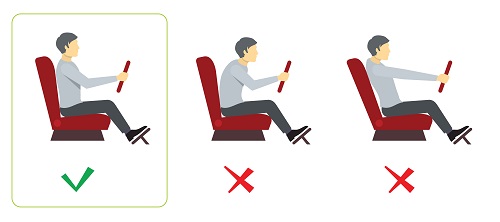Paying attention to ergonomics while driving, especially if driving takes a significant part of the day, is just as important as setting up your desk and workspace comfortably.

Anyone who spends a lot of time driving may be at risk for experiencing aches and pains.
Common complaints reported by drivers who spend a good deal of time on the road include:
- Stiff Neck
- Sore Shoulders
- Lower Back Pain
- Hip Strain
- Foot Cramps
- Fatigue
The main causes of the pain and discomfort drivers experience may be attributed to:
- Poor Posture
- Improperly Adjusted Seat
- Stress and Tension
- Low Frequency Whole-Body Vibration
- Long Periods of the Same Posture
There are many ergonomic adjustments drivers are encouraged to make to ensure driving does not add additional stress and strain on the body.

Poor driving posture can lead to an increased risk of pain and discomfort, and over time, bad posture can result in chronic pain making individuals vulnerable to more injuries. Maintaining good posture while driving eases the strain on the body.
While driving, don’t sit too close to or too far away from the steering wheel. Drivers should be able to comfortably reach the pedals and press them with the full range of the foot.
Drivers should allow sufficient room between their chest and the steering wheel so the seat belt and airbags can provide maximum safety protection. The driver’s knees should not be hitting the steering wheel column while driving.

Before starting any drive, focus on putting your body into a correct and comfortable posture in the driver’s seat, adjusting the seat as necessary.
Back Support. Slide back into the seat and aim for a 2-3 finger gap between the back of your knees and the front edge of the seat. The back of the car seat should support the full length of your back.
Hip Lift. Adjust the car seat and the way you are sitting so that your thighs are fully supported. If possible, your knees should be slightly lower than your hips. This seated position reduces stress on your hips and increases circulation while you are driving.
Eye Level. The car seat should be raised so eye level is at least 3-inches above the steering wheel.
Back Lean. Adjust the car seat so that it leans back just slightly past an upright 90-degree angle. Leaning the car seat to 100-110 degrees reduces strain on your lower back. Leaning your car seat too far back requires the driver to push their head and neck forward which can cause neck pain, shoulder aches and tingling in the fingers.
Headrest Position. The headrest should just touch the back of the head when sitting comfortably in the driver’s seat.

Ensure the vehicle you are driving accommodates your body type. Compact cars may lack the head space and leg room required for some drivers forcing them to place their bodies into uncomfortable positions to drive the vehicle. Some car seats don’t provide adequate support for the lower back putting additional strain on the spine. Adding a lumbar cushion or even a rolled-up towel may alleviate discomfort.
If the fleet, lease or rental vehicles provided by the organization do not allow you to drive comfortably, consider reaching out to the department responsible for those assignments to discuss options for driver health and safety.
Be sure to take periodic breaks, especially when driving for long periods of time. Park safely in a parking lot or rest area and get out of the vehicle to stretch and walk around. Listen to your body and take a break when fatigue begins to set in.
Even when your driving ergonomics are set up well for the drive, prolonged sitting, constrained postures, and the constant vibration of the vehicle can still cause stress on the body so plan ahead to take breaks during the drive.

Additional ergonomic safety tips to ensure driving is as safe and comfortable as possible:
Adjust the steering wheel to be about 10-12 inches from, and pointed towards, the center of your chest. The center of the steering wheel should not be pointed up towards your head or down towards your stomach.
To alleviate pressure points, you can make small adjustments in your posture while driving or even make minor adjustments to the seat if needed.
When driving for longer periods of time try gently moving your arms, legs, and neck when stopped at traffic lights to encourage circulation.
Remove your wallet, cell phone, and other items from your back pocket when getting in the car to drive. The added pressure of something as small as a wallet can cause the low back, hips, and pelvis to be uneven, which can cause back pain over time while driving.
Ensure the rearview mirror and side mirrors are all adjusted properly to prevent neck strain.


.jpg)
